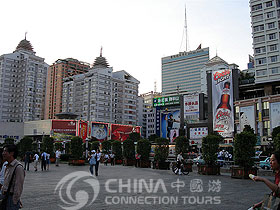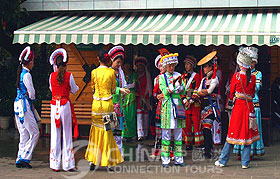 Kunming, the capital city of Yunnan Province, serves as the center of the province in terms of politics, economics and culture. It is a tourist city known for its perennially pleasant weather, intriguing highland scenes and sights, and venerated history. Thus it has been entitled as "one of the historical and cultural cities of China." Kunming, although a huge city, is exceptionally clean and tidy. The city has the best climate of all Chinese cities, and is popularly known as the "Spring City." The city's products include foodstuffs, trucks, machine tools, electrical equipment, textiles, chemicals, building materials and plastics.
Kunming, the capital city of Yunnan Province, serves as the center of the province in terms of politics, economics and culture. It is a tourist city known for its perennially pleasant weather, intriguing highland scenes and sights, and venerated history. Thus it has been entitled as "one of the historical and cultural cities of China." Kunming, although a huge city, is exceptionally clean and tidy. The city has the best climate of all Chinese cities, and is popularly known as the "Spring City." The city's products include foodstuffs, trucks, machine tools, electrical equipment, textiles, chemicals, building materials and plastics.
Kunming covers an area of 15,561sq.km with a population of 3.7 million. The area enjoys a pleasant climate with little change in temperature throughout the year. The temperature averages about 15 C in the urban area, 19.7 C in the summer and 7.5 C in the winter. Kunming does not have severe winters or hot summers and the natural features of the four seasons are clearly defined, the rainy season is between May and October when 85% of the annual rainfall of 1,000mm falls. The main rivers are the Nujiang, Lancang, Jinsha, Yuanjiang, and Nanpan.
 One fascinating aspect of the city is the many different cultures and nationalities thriving here. Various cultural and religious activities are practiced by the people and add to the vibrancy and color of Kunming city life. There are twenty-four ethnic minorities, mainly: Yi, Bai, Hani, Zhuang, Dai, Miao, Lisu, Hui, Lahu ,Va, Naxi, Yao, Tibetan, Jingpo, Bulang, Pumi, Nu, and Achang. Each group has its own language. The main religion in Kunming is Buddhism.
One fascinating aspect of the city is the many different cultures and nationalities thriving here. Various cultural and religious activities are practiced by the people and add to the vibrancy and color of Kunming city life. There are twenty-four ethnic minorities, mainly: Yi, Bai, Hani, Zhuang, Dai, Miao, Lisu, Hui, Lahu ,Va, Naxi, Yao, Tibetan, Jingpo, Bulang, Pumi, Nu, and Achang. Each group has its own language. The main religion in Kunming is Buddhism.
As long as 2,000 years ago, Kunming served as a major textile distribution center on the "Southern Silk Road." This section of the road started from Sichuan, traversed through Yunnan and continued on into Vietnam. In the 14th century the Ming Dynasty took over Yunnanfu, as Kunming was then known, building a walled town on the present site. In the 19th century, the city suffered several sieges at the hands of the sultan of Dali. Kunming came under western influence during the middle of the 19th century when France took control of Indochina, and Britain took control of Burma, accessing the city from the south. By 1900 Kunming had opened for foreign trade. The French sought to capitalize on the region's copper, tin and lumber resources and in 1910 their Indochina Railroad reached the city and is still in operation today. Kunming expanded during WWII, when factories were established and refugees from eastern China, fleeing the Japanese, poured into the city. Anglo-American forces sent supplies to Nationalist troops entrenched in Sichuan and Yunnan to help their efforts against the Japanese. Supplies came overland on the famous Burma Road, a 1000-km haul from Lashio to Kunming's Renmin Road, a road carved out of the mountains in 1937-38 by 160,000 Chinese with virtually no modern equipment.

